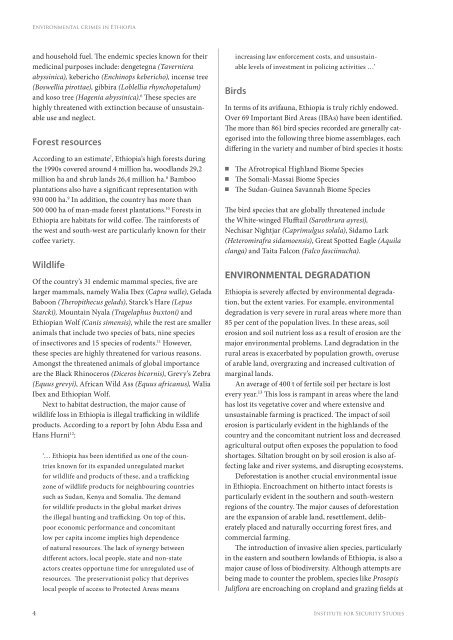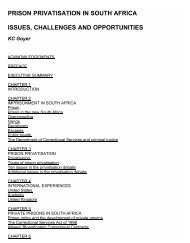4466 Environmental Crimes in Ethiopia.indd
4466 Environmental Crimes in Ethiopia.indd
4466 Environmental Crimes in Ethiopia.indd
You also want an ePaper? Increase the reach of your titles
YUMPU automatically turns print PDFs into web optimized ePapers that Google loves.
<strong>Environmental</strong> crimes <strong>in</strong> <strong>Ethiopia</strong><br />
and household fuel. The endemic species known for their<br />
medic<strong>in</strong>al purposes <strong>in</strong>clude: dengetegna (Taverniera<br />
abyss<strong>in</strong>ica), kebericho (Ench<strong>in</strong>ops kebericho), <strong>in</strong>cense tree<br />
(Boswellia pirottae), gibbira (Loblellia rhynchopetalum)<br />
and koso tree (Hagenia abyss<strong>in</strong>ica). 6 These species are<br />
highly threatened with ext<strong>in</strong>ction because of unsusta<strong>in</strong>able<br />
use and neglect.<br />
Forest resources<br />
Accord<strong>in</strong>g to an estimate 7 , <strong>Ethiopia</strong>’s high forests dur<strong>in</strong>g<br />
the 1990s covered around 4 million ha, woodlands 29,2<br />
million ha and shrub lands 26,4 million ha. 8 Bamboo<br />
plantations also have a significant representation with<br />
930 000 ha. 9 In addition, the country has more than<br />
500 000 ha of man-made forest plantations. 10 Forests <strong>in</strong><br />
<strong>Ethiopia</strong> are habitats for wild coffee. The ra<strong>in</strong>forests of<br />
the west and south-west are particularly known for their<br />
coffee variety.<br />
Wildlife<br />
Of the country’s 31 endemic mammal species, five are<br />
larger mammals, namely Walia Ibex (Capra walle), Gelada<br />
Baboon (Theropithecus gelads), Starck’s Hare (Lepus<br />
Starcki), Mounta<strong>in</strong> Nyala (Tragelaphus buxtoni) and<br />
<strong>Ethiopia</strong>n Wolf (Canis simensis), while the rest are smaller<br />
animals that <strong>in</strong>clude two species of bats, n<strong>in</strong>e species<br />
of <strong>in</strong>sectivores and 15 species of rodents. 11 However,<br />
these species are highly threatened for various reasons.<br />
Amongst the threatened animals of global importance<br />
are the Black Rh<strong>in</strong>oceros (Diceros bicornis), Grevy’s Zebra<br />
(Equus grevyi), African Wild Ass (Equus africanus), Walia<br />
Ibex and <strong>Ethiopia</strong>n Wolf.<br />
Next to habitat destruction, the major cause of<br />
wildlife loss <strong>in</strong> <strong>Ethiopia</strong> is illegal traffick<strong>in</strong>g <strong>in</strong> wildlife<br />
products. Accord<strong>in</strong>g to a report by John Abdu Essa and<br />
Hans Hurni 12 :<br />
‘… <strong>Ethiopia</strong> has been identified as one of the countries<br />
known for its expanded unregulated market<br />
for wildlife and products of these, and a traffick<strong>in</strong>g<br />
zone of wildlife products for neighbour<strong>in</strong>g countries<br />
such as Sudan, Kenya and Somalia. The demand<br />
for wildlife products <strong>in</strong> the global market drives<br />
the illegal hunt<strong>in</strong>g and traffick<strong>in</strong>g. On top of this,<br />
poor economic performance and concomitant<br />
low per capita <strong>in</strong>come implies high dependence<br />
of natural resources. The lack of synergy between<br />
different actors, local people, state and non-state<br />
actors creates opportune time for unregulated use of<br />
resources. The preservationist policy that deprives<br />
local people of access to Protected Areas means<br />
<strong>in</strong>creas<strong>in</strong>g law enforcement costs, and unsusta<strong>in</strong>able<br />
levels of <strong>in</strong>vestment <strong>in</strong> polic<strong>in</strong>g activities …’<br />
Birds<br />
In terms of its avifauna, <strong>Ethiopia</strong> is truly richly endowed.<br />
Over 69 Important Bird Areas (IBAs) have been identified.<br />
The more than 861 bird species recorded are generally categorised<br />
<strong>in</strong>to the follow<strong>in</strong>g three biome assemblages, each<br />
differ<strong>in</strong>g <strong>in</strong> the variety and number of bird species it hosts:<br />
■<br />
■<br />
■<br />
The Afrotropical Highland Biome Species<br />
The Somali-Massai Biome Species<br />
The Sudan-Gu<strong>in</strong>ea Savannah Biome Species<br />
The bird species that are globally threatened <strong>in</strong>clude<br />
the White-w<strong>in</strong>ged Flufftail (Sarothrura ayresi),<br />
Nechisar Nightjar (Caprimulgus solala), Sidamo Lark<br />
(Heteromirafra sidamoensis), Great Spotted Eagle (Aquila<br />
clanga) and Taita Falcon (Falco fasci<strong>in</strong>ucha).<br />
ENVIRONMENTAL DEGRADATION<br />
<strong>Ethiopia</strong> is severely affected by environmental degradation,<br />
but the extent varies. For example, environmental<br />
degradation is very severe <strong>in</strong> rural areas where more than<br />
85 per cent of the population lives. In these areas, soil<br />
erosion and soil nutrient loss as a result of erosion are the<br />
major environmental problems. Land degradation <strong>in</strong> the<br />
rural areas is exacerbated by population growth, overuse<br />
of arable land, overgraz<strong>in</strong>g and <strong>in</strong>creased cultivation of<br />
marg<strong>in</strong>al lands.<br />
An average of 400 t of fertile soil per hectare is lost<br />
every year. 13 This loss is rampant <strong>in</strong> areas where the land<br />
has lost its vegetative cover and where extensive and<br />
unsusta<strong>in</strong>able farm<strong>in</strong>g is practiced. The impact of soil<br />
erosion is particularly evident <strong>in</strong> the highlands of the<br />
country and the concomitant nutrient loss and decreased<br />
agricultural output often exposes the population to food<br />
shortages. Siltation brought on by soil erosion is also affect<strong>in</strong>g<br />
lake and river systems, and disrupt<strong>in</strong>g ecosystems.<br />
Deforestation is another crucial environmental issue<br />
<strong>in</strong> <strong>Ethiopia</strong>. Encroachment on hitherto <strong>in</strong>tact forests is<br />
particularly evident <strong>in</strong> the southern and south-western<br />
regions of the country. The major causes of deforestation<br />
are the expansion of arable land, resettlement, deliberately<br />
placed and naturally occurr<strong>in</strong>g forest fires, and<br />
commercial farm<strong>in</strong>g.<br />
The <strong>in</strong>troduction of <strong>in</strong>vasive alien species, particularly<br />
<strong>in</strong> the eastern and southern lowlands of <strong>Ethiopia</strong>, is also a<br />
major cause of loss of biodiversity. Although attempts are<br />
be<strong>in</strong>g made to counter the problem, species like Prosopis<br />
Juliflora are encroach<strong>in</strong>g on cropland and graz<strong>in</strong>g fields at<br />
4 Institute for Security Studies
















